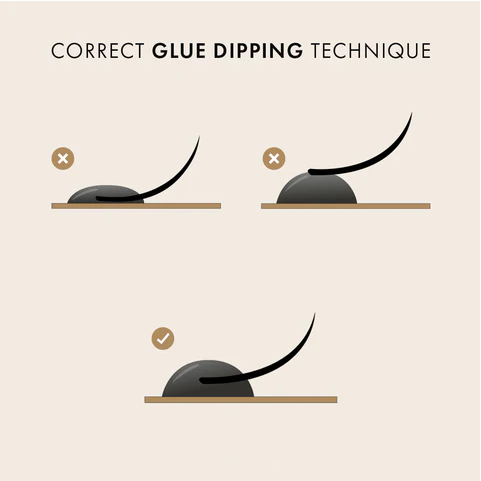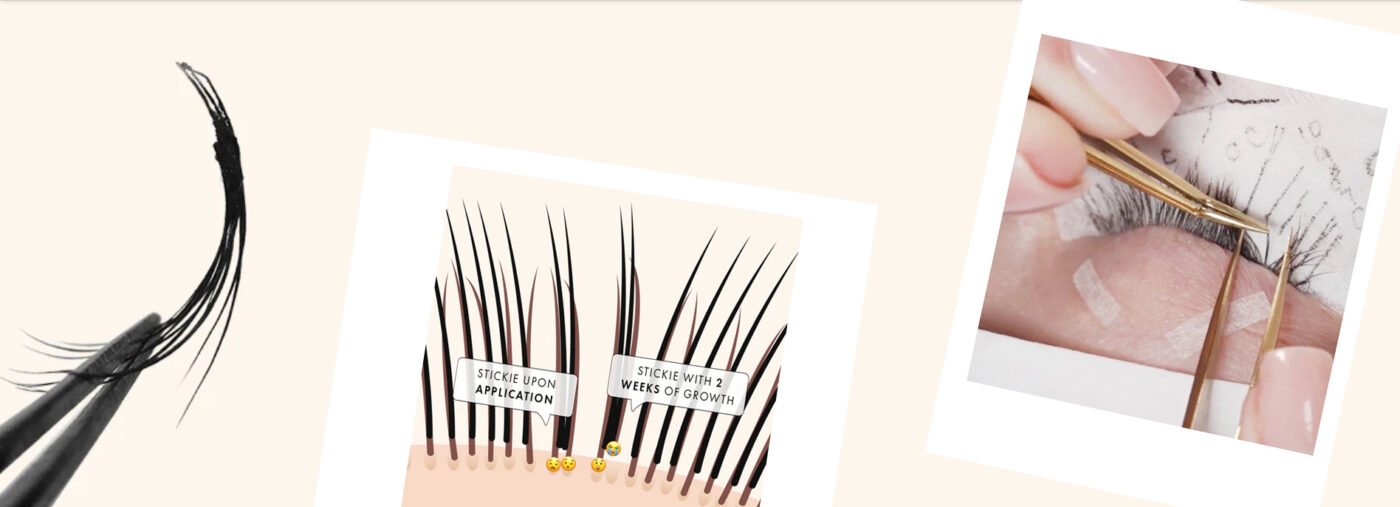Blog
Understanding And Preventing Eyelash Extension Stickies
What, why, and how?
What Are Eyelash Extension Stickies?
The first type of stickie is when a baby natural lash gets stuck to an adjacent eyelash extension. These are one of the most common mistakes made when applying lash extensions, and also one of the most damaging types of stickies!
The second type of stickie is when two lash extensions are stuck together. This type of stickie is the easiest to spot when checking your lash sets at the end of the treatment.
The third type of stickie is when two natural lashes are stuck together. This can happen when you have placed an eyelash extension on a natural lash but have taken it off again, either due to bad positioning or too much eyelash glue.

What Makes Eyelash Extension Stickies So Damaging?
Well, we know the natural lashes have different stages of growth. Baby natural lashes grow much quicker than a full-grown natural lash that is in the ‘resting stage’. If a baby natural lash gets stuck to a full-grown natural lash, it will keep growing and can pull out that resting natural lash, not only causing discomfort for your clients, but also potentially causing permanent damage to that hair follicle. How many times have you heard someone say ‘Eyelash extensions have ruined my natural lashes!’? Well, if it wasn’t for stickies and poor application, eyelash extensions won’t actually cause any damage to the natural lashes!
How Can You Prevent Eyelash Extension Stickies?
1. The first step for preventing stickies is to correctly isolate the individual lashes.
2. Second, is to always ensure that you’re correctly dipping your lash extensions to pick up the right amount of eyelash extension glue, just a small ball is enough, not a big blob!

There are 2 different techniques that you can use to avoid stickies when it comes to applying your lash extensions. The first technique is ‘lash by lash’. This is where you simply apply an eyelash extension to a natural lash, then apply another to the lash directly next to it, and so on. However, this technique can be risky because if the lash glue on the eyelash extension you’ve just applied hasn’t dried properly before you apply the next one, then you can easily get into a sticky situation when applying the next eyelash extension with them getting stuck together!
The next technique is probably the safest. This is where you apply one eyelash extension, then leave a gap of, say, 10 natural lashes before applying the next eyelash extension, giving the lash glue of the first eyelash extension enough time to dry properly before applying the next lash. It is also beneficial to work evenly across both eyes as this will not only give your eyelash glue even more time to dry, but will also help to ensure symmetry across both eyes and their lashes.
How To Check Your Lash Sets For Stickies
Checking your work for stickies is an important part of your lash procedure – it’s all about safety! Make sure that you always save at least 10 minutes at the end of each treatment in order to do this thoroughly and correctly.
The first way you can check for stickies is to check each and every individual lash from root to tip with your eyelash tweezers.
The second is to check the lashes in layers – you are almost guaranteed to find at least one stickie between the layers!
Top Tip: If you’re competing in an eyelash extension competition, it’s also very important that you check for stickies as you can lose points when you have too many stickies!
Dealing with eyelash extension stickies can be a real sticky situation—but it doesn’t have to be! Remember, stickies happen when individual lashes aren’t isolated properly or if you’re a bit heavy-handed with your lash glue. This not only makes your client uncomfortable but can also harm their natural lashes. Stick to these tips, and you’ll keep those lashes looking flawless and your clients smiling!

